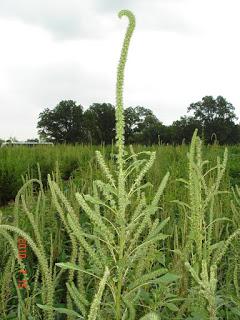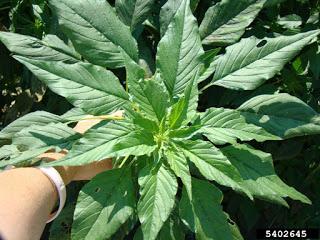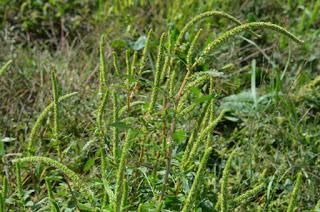Palmer amaranth is on the Minnesota Noxious Weed List in the "prohibited-eradicate noxious weeds" category. This legal status means the plant must be destroyed and that no transportation, propagation or sale of this plant species is allowed.
Report possible infestations to the Minnesota Department of Agriculture (MDA). You can use their online reporting form, email them at reportapest@state.mn.us, or call 1-888-545-6684.
View MDA information on Palmer amaranth in Minnesota.
Palmer amaranth (Amaranthus palmeri) has been confirmed in Minnesota. Efforts to eradicate this weed are critical to Minnesota’s commodity crop producers.
Palmer amaranth isn’t native to the northern United States but has spread northward from southern states. It’s been confirmed in Wisconsin, Iowa, Illinois, Nebraska, South Dakota and other northern states.
In August 2016, it was discovered in newly seeded Conservation Reserve Program (CRP) land in Iowa, and confirmed in Yellow Medicine County in Minnesota, that September.
Why Palmer amaranth is a threat
Palmer amaranth is the most competitive and aggressive pigweed species. It’s related to waterhemp and, like waterhemp, it emerges throughout the growing season, from May to August. However, Palmer amaranth is much more aggressive than waterhemp, growing 2 to 3 inches a day.
Herbicide resistance
Palmer amaranth can quickly adapt to herbicide management tactics that don’t include diverse effective sites of action (SOAs), ultimately limiting control options. In the northern states, Palmer amaranth is expected to be resistant to multiple herbicides, including glyphosate (SOA group 9) and acetolactate synthase (ALS) inhibitors (SOA group 2).
- Palmer is dioecious, with male and female plants. Outcrossing results in the rapid spread of herbicide resistance.
- It’s a prolific seed producer, with a single female plant typically producing 100,000 to 500,000 seeds.
- Timing of herbicide application is critical. Effective preemergence herbicides must be followed by timely (plants less than 3 inches tall) and effective postemergence herbicides.
Threat to crop production
Palmer amaranth infestations have caused substantial yield losses and greatly increased weed management costs in cotton, soybeans and corn in the southern states. Once established in the northern corn and soybean states, it’ll likely do the same and significantly increase costs and decrease yields.
How to handle infestations
Palmer amaranth’s legal status as a state-prohibited noxious weed on the “Eradicate” list means the plant must be destroyed and that no transportation, propagation or sale of this plant species is allowed.
This law gives MDA, county, city and township officials the right to inspect land areas believed to be affected by this weed and ask owners to destroy the plants. It also allows MDA officials to investigate where potential seed lot contamination sources are occurring.
How to report
If you suspect a weed is a Palmer amaranth, email the following to reportapest@state.mn.us.
Your location.
The plants’ location. Be as specific as possible.
A description of the area where the plant was found.
Your contact information.
Seed source (if known).
Photos (similar to those under Identifying).
Entire plant
Petiole (where the leaf connects to the stem)
Seed head
After photographing and reporting, an MDA staff member will review and contact you if more information is needed.
- Do not let the plants in question go to seed in the field. See below for tips on destroying the plants.
- Do remove and save some plant material until the species has been confirmed.
- Live plant material can be placed in a paper bag and refrigerated while dead material can be placed in a paper bag and stored at room temperature.
- The MDA may request some plant tissue for genetic testing to confirm identification.
Destroy the plants
Destroy the plants after photographing and reporting them to MDA.
Note: The timeframe is very short to eradicate the plant. Due to the economic significance of this invasive weed, it’s worth our collective effort to try.
Small populations
If the Palmer amaranth population is small in number:
Weed plants by hand.
Place them in a large paper bag.
Remove them from the field to a site suitable for burning the plants.
Burn the plants.
Larger populations
For a larger population of plants at the mature stage of the weed’s life cycle, particularly when the seed is being set:
Mow the area.
Clean off the mower on-site. This prevents the spread of any weed seed shed onto the mower.
Mowing doesn’t kill the entire plant, but it’ll keep the seed on the ground in the affected area where insects and rodents can feed on it. Mowing will reduce movement away from the affected area. Plus, any seed that germinates the following year will have to compete with the more established plants that surround it.
It’s important to closely monitor the affected and surrounding area the following year to make sure there are no weeds that escaped detection or seeds that have moved into adjacent lands. By reporting your affected site to the MDA, they’ll be able to assist you with this monitoring procedure.
Why report?
This information helps the MDA understand the weed’s current distribution and its potential to spread to your fields and adjacent lands. Reporting also allows local officials to help monitor the site in subsequent years to make sure there are no escapes. This is particularly important if land ownership changes.
Handling Palmer amaranth
First, scout your fields with a particular focus on native seed planting areas.
Look for pigweed plants that can reach heights of 6 to 7 feet in unmown areas, as well as the following key characteristics:
Leaves: Ovate- to diamond-shaped leaves, which give it a poinsettia-like appearance. No hairs.
Inflorescences: Prolific seed producer with a long main terminal seed head (inflorescence) that’s up to 3 feet long. Female inflorescence have sharp, spiny bracts.
Plant characteristics: No hairs on stems and leaves, unlike redroot pigweed. Petiole is as long as or longer than the leaf.
Additional guidance:
Palmer amaranth has spread from the south through:
Contaminated feed, including cottonseed, sunflower seed screenings, and hay.
Contaminated grain and seed.
Farm equipment and manure.
Palmer amaranth in manure
The Minnesota Department of Agriculture has identified manure as a pathway for Palmer amaranth's introduction to the state. Specifically, Palmer amaranth seeds that contaminated sunflower screenings were fed to cattle. Some of those seeds survived digestion, and when that manure was spread onto cropland, those seeds germinated.
Many factors affect seed viability in manure. The following practices may help reduce Palmer seed viability in feed and manure and reduce the risk of applying contaminated manure to the field.
Reducing Palmer amaranth seed in feed
Don't assume animal digestion will kill all of the seeds
Though it will reduce weed seed viability, simply feeding the contaminated material to livestock will not eliminate all Palmer amaranth seed. Grass and soft-coated broadleaf seeds are more easily destroyed in digestion than hard-coated seeds – such as Palmer amaranth. In rumen animals, such as cattle, 27% of amaranth seed remained viable after digestion. The gizzard digestive system of poultry is highly effective at destroying weed seeds, and only 3.5% of Palmer amaranth seeds fed to ducks were recovered and found viable.
Ensile the feed (if appropriate for feed type)
The fermentation and heat generated during ensiling is quite effective for killing weed seeds. Just one month after contaminated alfalfa haylage was stored, amaranth seed viability dropped by 41%; and in corn silage, the drop was even greater at 60%. Logically, seed viability continues to decrease as silage storage time increases. Eight weeks of ensiling killed up to 87% of viable amaranth seed; and when feed went through both ensiling and rumen digestion, the seed mortality increased to 89%.
Reducing Palmer amaranth in manure
Compost solid manure
Internal heat generated by properly composting manure will kill most weed seeds – even the hard-seeded Palmer amaranth. The key word here is “properly.” Aged manure is not composted manure. Proper composting requires active management and must be monitored and aerated for correct weed-killing conditions to develop.
Temperature and moisture are the two most crucial elements for seed mortality in compost. For Palmer amaranth, researchers found that sustaining the compost at 140⁰F for three days will virtually eliminate seed viability, so long as a minimum of 35% moisture is maintained. To account for temperature and moisture uniformity issues that are prevalent in composting, exceeding these minimums and composting at 160⁰F for four days with 50% moisture is recommended. Another study found that it took between 21 and 50 days of composting with proper management to eliminate amaranth seed.
However, research trials reached 0% viable weed seeds under the best compost management practices possible in a very controlled environment. In contrast, an actual on-farm survey of composting sites found that while composting did reduce weed seed viability 90-98% over six to eight weeks, there was still potential for seed survival. This seed survival - or mortality escape - varied by operation and weed species. It is theorized that this mortality escape is due to cooler pockets that do not sustain high temperatures for long enough. Therefore, just because manure has been composted does not necessarily mean it is weed-seed-free.
Liquid options are limited
Obviously, liquid manures cannot be piled for composting, and pit storage – including the anaerobic conditions in deep pits – does not significantly contribute to amaranth seed mortality. Barring expensive heat treatment of the manure, the best option here is application followed by diligent and frequent scouting.
Don't rely on anaerobic digestion
Though anaerobic digestion of manure may reduce the seed viability of some weeds, it has not been found to affect amaranth germination beyond the benefits of animal digestion alone.
Field application of contaminated manure
Transport it to nearby fields that can be easily and frequently scouted. Even if the feed was ensiled and the manure was composted before spreading, it’s still possible for weed seeds to remain viable. A 98% reduction in viability seems sufficient, but even low seed survival rates can be problematic. A survey of fresh dairy manure in New York found an average of 75,000 viable seeds per ton and a range of 0 to 400,000 seeds. Two percent survival of 75,000 would leave 1,500 viable seeds remaining per ton. Applied at 8 tons per acre, that would increase the weed seed bank by 12,000 seeds per acre. This “numbers game” is especially precarious in the case of Palmer amaranth since Minnesota hopes to entirely eradicate it, as it would be fairly easy for just one or two seeds to slip through to the field.
Apply the highest rates of manure (according to Minnesota Pollution Control Agency guidelines) to the fewest number of fields as possible to minimize the spread of the seed. If these fields can be planted to more competitive crops such as alfalfa, grass pasture, or small grains that could also help by smothering the weed.
Scout fields after application
It is crucial to scout early and often for Palmer amaranth in fields that have received possibly contaminated manure. Since this weed has an extended emergence period ranging from May through July, it is important to continually monitor fields.
If you find a plant that you suspect is Palmer amaranth, be sure to follow the directions in the "How to handle infestations" section above.
Conservation plantings
In Iowa and Indiana, the most recent infestations were in newly seeded conservation plantings (i.e., Conservation Reserve Program (CRP), wildlife, pollinator and cover crop plantings) where the seed mix was contaminated. Ohio and Illinois also reported contaminated conservation seed mixes as a source of Palmer amaranth introduction.
Palmer amaranth may not persist in areas being established for conservation habitat. This is because Palmer amaranth should be crowded out once native, perennial vegetation is established. However, until perennial plants become established, Palmer amaranth may produce enough seed to establish a seed bank and move into neighboring corn and soybean fields.
Download this information as a PDF.
More about Palmer amaranth in other states:
Early identification is key to prevent the spread of Palmer amaranth. If plants are found, remove and destroy them. Above all, they shouldn’t be allowed to go to seed.
According to Minnesota statutes, landowners must attempt to eradicate any Palmer amaranth found by destroying all the above and below ground parts of the plants.
Report any weeds found on the MDA’s Eradicate list to 1-888-545-6684 or reportapest@state.mn.us.
Full labeled rates of residual herbicides with multiple Site of Actions (SOAs) are a must in corn and soybeans.
If a field becomes infested, rotate it to a crop with more diverse management options, such as alfalfa, small grains or even corn.
Early postemergence herbicide applications (when Palmer is less than 3 inches) are critical in managing this weed. Remember, Palmer can grow 2 to 3 inches in a day, so it can quickly exceed heights that herbicides can acceptably control.
In addition to contacting the MDA if you suspect Palmer amaranth, please contact University of Minnesota weed scientists:
- Debalin Sarangi, Extension weed management specialist, dsarangi@umn.edu
- Tom Peters, Extension sugarbeet agronomist, pete7440@umn.edu
Allan, D., Katovich, E., and Nelson, C. 2003. Weed seed survival as affected by manure handling. Presented at “Anaerobic Digester Technology Applications in Animal Agriculture: A National Summit.” June 2-4, 2003. Raleigh, NC.
Blackshaw, R. and Rode, L. 1991. Effect of ensiling and rumen digestion by cattle on weed seed viability. Weed Sci. 39(1):104-108.
Cudney, D., Wright, S., Schultz, T., and Reints, J. 1992. Weed seed in dairy manure depends on collection site. California Agric. 46:31-32.
Eckford, R., Newman, J., Li, X., and Watson, P. 2012. Thermophilic anaerobic digestion of cattle manure reduces seed viability for four weed species. Int. J. Agric. & Biol. Eng. 5(1):71-75.
Farmer, J., Webb, E., Pierce, R., and Bradley, K. 2017. Evaluating the potential for weed seed dispersal based on waterfowl consumption and seed viability. Pest Manag. Sci. 73:2592-2603.
Grundy, A., Green, J., and Lennartsson, M. 1998. The effect of temperature on the viability of weed seeds. Compost Sci. Util. 6(3):26-33.
Katovich, E. and Becker, R. 2004. Weed seed survival in anaerobic digesters. USDA NRCS EQIP Edu. Assis. Grant Prog. Final Report.
Reviewed in 2024






